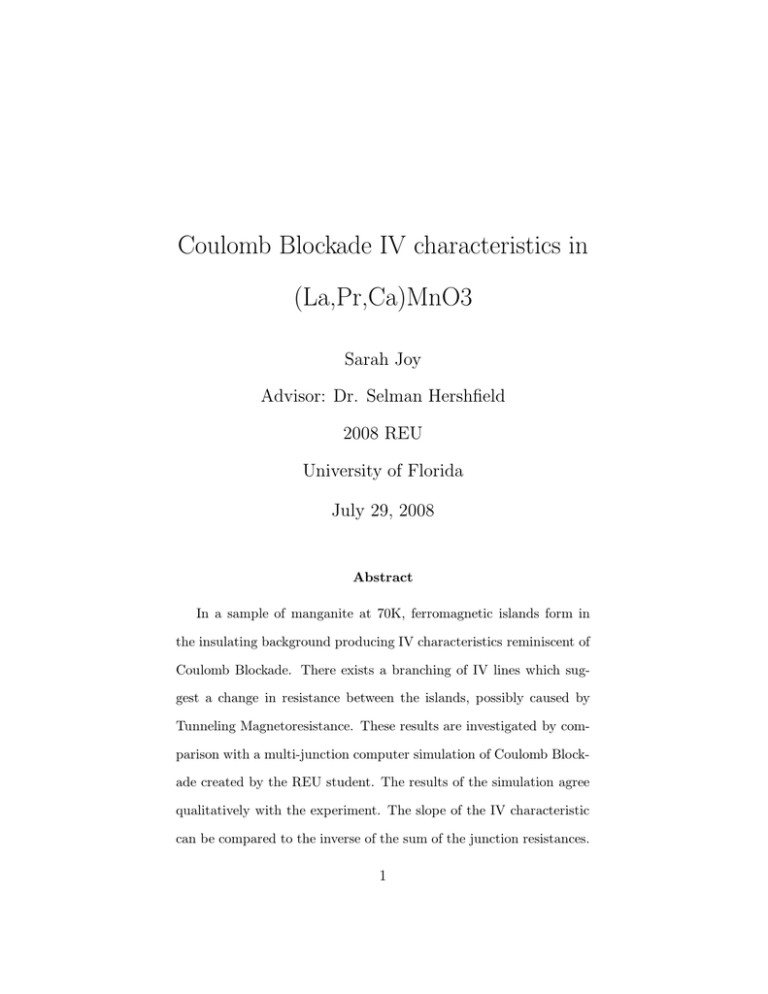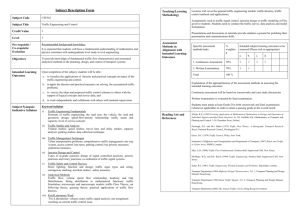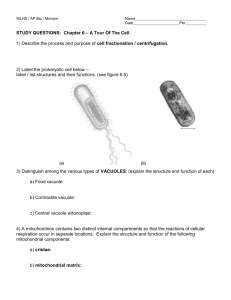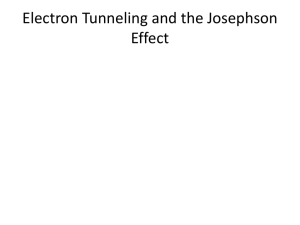Coulomb Blockade IV characteristics in (La,Pr,Ca)MnO3 Sarah Joy Advisor: Dr. Selman Hershfield
advertisement

Coulomb Blockade IV characteristics in (La,Pr,Ca)MnO3 Sarah Joy Advisor: Dr. Selman Hershfield 2008 REU University of Florida July 29, 2008 Abstract In a sample of manganite at 70K, ferromagnetic islands form in the insulating background producing IV characteristics reminiscent of Coulomb Blockade. There exists a branching of IV lines which suggest a change in resistance between the islands, possibly caused by Tunneling Magnetoresistance. These results are investigated by comparison with a multi-junction computer simulation of Coulomb Blockade created by the REU student. The results of the simulation agree qualitatively with the experiment. The slope of the IV characteristic can be compared to the inverse of the sum of the junction resistances. 1 Introduction (La, P r, Ca)MnO3 exhibits curious and exotic properties currently under active investigation. These manganites may contain different electronic and magnetic phases throughout the crystal [1]. These coexisting phases may be easily changed by varying parameters such as temperature and magnetic field. Manganites also display the colossal magnetoresistance effect (CMR). CMR results when an applied magnetic field induces a large change in the resistance of the sample. The change arises from a phase change from an insulating material to a spin aligned metal. Magnetoresistance remains important for magnetic sensors such as those seen in hard drives. Unfortunately, the CMR only occurs well below room temperature. Another interesting property of manganites has been seen in the labs of Dr. Art Hebard and Dr. Amlan Biswas at the University of Florida. Guneeta Singh, a PhD student of Dr. Hebard, conducted an experiment that involved fabricating a thin-film device with a sample of manganite attached to a substrate. As the temperature surrounding the device was lowered, small metallic islands began to form in the previously completely insulating sample. The tiny structure of metallic regions with an insulating material between them characterizes a tunnel junction. Classically, an electron cannot move through an insulator, but quantum mechanically there exists a nonvanishing probability the particle will tunnel through; thus we use the term tunnel junction. The sample of manganite naturally created multiple junctions at 70K. 2 Figure 1: IV curve of manganite at 70K and 2kOe (159kA/m), showing the e2 e2 > eV and then linearly increasing once eV > 2C . current equaling zero for 2C It is clear that the current branches off with different slopes at for different sweeps higher voltages. [Plot courtesy of G. Singh] In the experiment, Singh drove a current through the sample and measured the voltage to obtain the IV characteristics (graph of current versus voltage). These IV characteristics appear to show the Coulomb blockade. The Coulomb blockade occurs when the charging energy, e2 , 2C becomes greater than the thermal energy, kB T , or the energy given by the applied voltage, eV [2]. When an electron tunnels, the energy across the junction increases, and if this energy becomes larger than the energy the electrons have, then no current flows. The current remains suppressed if eV < the IV characteristic to be very small until eV > e2 . 2C e2 . 2C This causes Once the bias voltage rises above the junction voltage, current begins to flow again. The IV curve 3 characterizes this phenomenon. The IV plot of the device in the experiment, Fig. 1, displays a very similar curve and contains a similar structure of tunnel junctions which implies a Coulomb Blockade effect. Figure 2 shows an IV curve from our Coulomb Blockade simulations. Current (I/eC0R0) 1 -6 -4 -2 0 2 4 6 0.5 0.5 0 0 -0.5 -1 1 -0.5 -6 -4 -2 0 2 4 6 -1 Voltage (VC0/e) Figure 2: IV curve for Coulomb Blockade, created using a Coulomb blockade simulation for three junctions. The offset, or first value of voltage giving a nonzero current, is 0.4V for this plot. It looks very much like the experimental plot in Figure 1. My project consists of modeling Coulomb Blockade for the manganite case of multiple junctions and analyzing the data for a model based on the resistances between the junctions. Changes in the resistance might be responsible for the multiple lines seen in the experiment’s IV curve. Understanding how Coulomb Blockade applies to experimental data constitutes the purpose of this project. Thus I began to develop a code that would give the steady state current in a Coulomb Blockade situation. I first created a simulation of two junctions using two capacitors in series with a voltage source in parallel 4 as a theoretical model. My advisor studied this case previously, and therefore I could check the accuracy of my results [3]. Once I felt comfortable with two junctions, I created a code for three-and-four junction cases. The final objective requires finding an analytical expression for the IV characteristics in the two-junction case, and testing whether the tunneling magnetoresistance (TMR) causes the resistance of the junctions to vary. TMR occurs when an applied magnetic field causes the resistance between the junction to change as a result of the ferromagnetic domains re-orienting. Accomplishing the former objective would give a model for the experiment’s IV curve. Proving the latter objective would provide an explanation for the experiment’s IV curve. Procedure Fig. 3 depicts our model for the internal structure of the manganite at 70K: two thin paramagnetic insulators surrounded by a metallic island with electrodes at the ends. This figure represents a two-junction case, because two insulating regions exist. The theoretical model for this case consists of two capacitors in series, with an applied voltage across the two. An electron may tunnel to or from the island with an applied voltage or driven current. The number of excess electrons n on the island defines a state. The number of states depends on the number electrons and number of junctions. For two junctions the number of states equals 2ne + 1 where ne is the total number of electrons considered in the system. Since computers cannot handle an 5 infinite number of electrons, I increased this parameter until the IV characteristic converged and that value of ne was used. Figure 3: Two-junction model of manganite structure at 70K. A is the left electrode, E is the right electrode, B and D are paramagnetic insulators and C is the metallic island. A,B and C represent one junction while C, D and E represent the second junction. Four possible transitions exist for two junctions: an electron may tunnel to/from the island from/to the left electrode or from/to the right electrode. The transition of one electron across a barrier gives a change in energy of ∆Ui = ±eV̄i , (1) where i indicates which junction the electron tunneled across and ∆U remains positive with a left to right transition and negative from right to left. For example, an electron tunneling from the island to the left electrode gives 6 a change in energy of −eV̄L where V̄L represents the average (of the inital and final) voltage across the left junction. The rate of transition is given by Fermi’s Golden Rule ΓL→R = 1 e2 R −∆U , (1 − eβ∆U ) (2) where β is the inverse of the product of Boltzmann’s constant and temperature and R is the resistance across the junction that the electron tunneled. The sign of ∆U reverses if the electron travels from right to left. Once an electron tunnels it must decide where to go next. The Master equation accomplishes this by giving the time evolution of a system: dρi = Γi−1→iρi−1 + Γi+1→i ρi+1 − Γi→i−1ρi − Γi→i+1 ρi , dt (3) where ρi is the probability of being in state i and Γi→j is the net rate for that transition. This equation may be written in matrix form as dρ dt = Mρ with ρ a column vector and M a matrix filled with rates. We require only the steady state current and so Mρ0 = 0 may be solved for ρ0 . Current is defined in the following way: IL = Σi (−eΓLi→i+1 ρ0i + eΓLi+1→i ρ0i+1 ), (4) 0 R 0 IR = Σi (eΓR i−1→i ρi−1 − eΓi→i−1 ρi ). (5) These expressions may be put into matrix form as IL(R) = −eΣi (vL(R) ρ0 )i 7 where v is a matrix containing all rates. According to the continuity equation, IR = IL in the steady state limit. That condition, the shape of the plots, and ρ at zero voltage define the conditions for correctness. Once I finished the two-junction case and checked it, I began creating a simulation for multiple junctions. The code simulates either a three or four junction case. This model contains essentially the same equations as for two junctions with slight differences to accommodate for the increase in junctions and islands. I tested this code using the same conditions for two junctions until it performed as expected. I then explored the relationship between the input parameters and the slope and offset of the plots. Some IV curves in the experiment display multiple lines branching out from the offset and we needed to discover the cause. I ran simulations for three junctions (in the interest of time) varying the resistance while holding capacitance constant, as displayed in Figure 4. The offset does not appear to be affected by this change, but the slope clearly shifts; it increases with a smaller total resistance and decreases with a increase in the total resistance. The offset, or value of voltage associated with the first nonzero current value, came out to be 0.35V for each set of resistances in Fig. 4. I then plotted V Σi Ri over the current for each set of resistances, and they fit well together in the high voltage limit. This means that the inverse sum of resistance determines the slope of the IV curve at large voltages. Finally, I compared the percent change in slope of the experimental plots to the 8 0 Current (I/e/V0R0) 0.25 0.5 1 1.5 2 0.25 R R1 R2 R3 V/R0 0.2 0.15 0.1 0.2 0.15 0.1 0.05 0.05 0 0 -0.05 -0.05 -0.1 -0.1 0 0.5 1 1.5 2 Voltage (VC0/e) Figure 4: Current vs voltage for fixed total capacitance, C0 and different values Rn of total resistance where e = 1. The black line resulted from the original resistances chosen, and has a line plotted over it with slope R10 starting at high voltages. The purple line plotted over the black shows that dI = R10 is in good agreement with the actual slope at high voltages. The dV offset is 0.35V for all lines. The first resistance value, R1 was changed and plotted in red. Then the second value of resistance was changed, R2 from the original and ploted in green, and the same was done for R3 in blue. The ratio of R1 changed from 0.1924 to 0.4247, from 0.3482 to 0.5388 for R2 and R0 from 0.4555 to 0.5898 for R3 where R0 is the total resistance of each line (R0 is different for each ratio). change in resistance for one junction in the TMR regime. Since we are dealing with multiple junctions, a decrease from the 10 % change seen in TMR would be expected because the slope would be the inverse of the sum of all the resistances. When compared to Singh’s data, an increase actually occured. Therefore we do not believe TMR is responsible, though more data are needed. 9 0 1 1.5 2 C offset=0.39V C1 offset=0.25V C2 offset=0.51V C3 offset=0.28V 0.25 Current (I/e/R0C0) 0.5 0.2 0.15 0.25 0.2 0.15 0.1 0.1 0.05 0.05 0 -0.05 0 0 0.5 1 1.5 2 -0.05 Voltage (C0V/e) Figure 5: Current vs voltage for different values of Cn where e = 1. This shows the shifts in the offset when the capacitance is changed one at a time, from the original values; the slope remains the same at high voltages. For C1, the ratio C1 went from 0.2611 to 0.4259, from 0.5796 to 0.4105 for C2 C0 and from 0.1593 to 0.3467 for C3. Next I slowly varied the capacitance and kept the resistance constant (see Fig. 5) which shifted the offset and seems to have affected the slope slightly. With a rise in capacitance, the offset decreases. These graphs both contain data using a low temperature. Conclusion The multiple junction Coulomb blockade simulation gives IV characteristics that agree qualitatively with the experiment, including an initial offset followed by a rise in the IV curve. The structure of the manganite at 70K consists mostly of metal separated by thin insulators which matches the 10 structure of the artificial atoms in which Coulomb blockade was seen [4]. Finally, the blockade effect disappears once the material turns to all metal or all insulator. For all of these reasons, we conclude that Coulomb blockade takes effect at this temperature in the sample. Also, when the capacitance in the simulation changes, the offset of the IV curve changes. This effect does not take place in the experiment, so we may infer that capacitance does not vary inside the sample. We do believe the resistance varies because of the different slopes seen at the same temperature in the experiment and simulation. The inverse of the sum of the resistances between each junction determines the slope of the IV curve, dI/dV = 1/ΣR as proved numerically. Planned future work includes understanding the simulation more analytically by finding an expression for the current in the two-junction case. This would give a definite relationship between the offset and slope. This would be useful to experimentalists. Other work will involve finding what could be causing the high change in resistances and gathering more data to help find possibilities. Acknowledgements I would like to thank Dr. Hershfield for his guidance, support, and patience throughout the summer. I would also like to thank Guneeta Singh for answering all my questions, Dr. Biswas for the lectures and helpful insight, Dr. Ingersent and Kristin Nichola for running the program so well, and finally 11 the National Science Foundation for funding the program. References [1] N. Mathur and P. Littlewood, Phys. Today, 1,25 (2003) [2] B. Goss Levi, Phys.Today, 5,19 (1988) [3] S. Hershfield et al., Phys. Rev. B , 47,1967 (1993) [4] M.A. Kastner, Phys.Today, 1,24 (1993) 12






